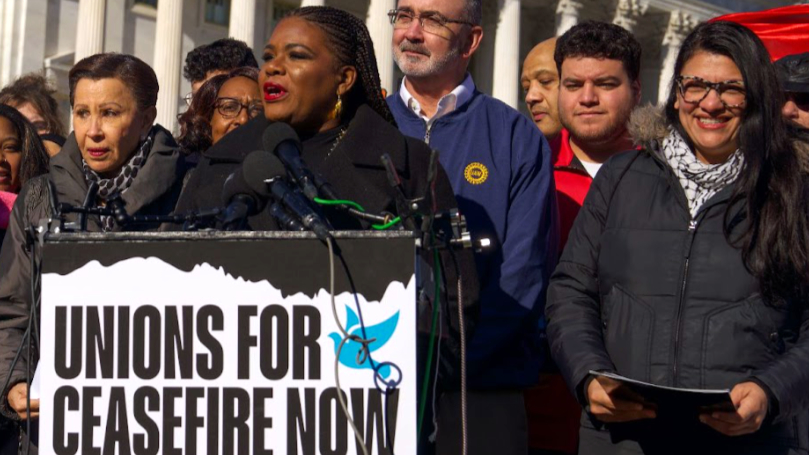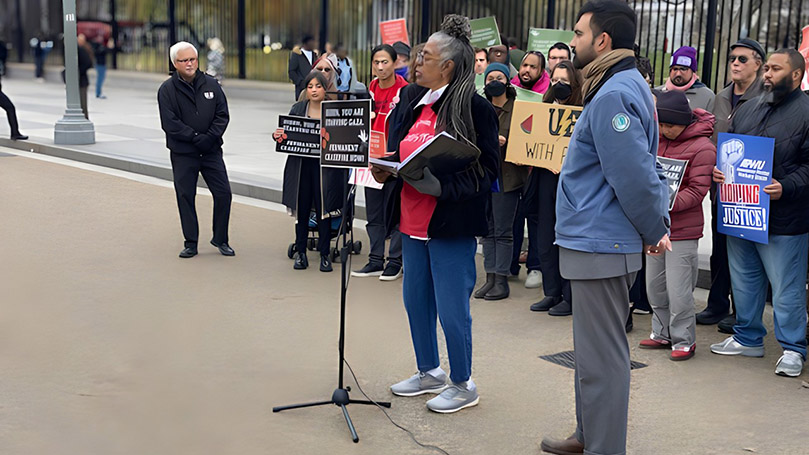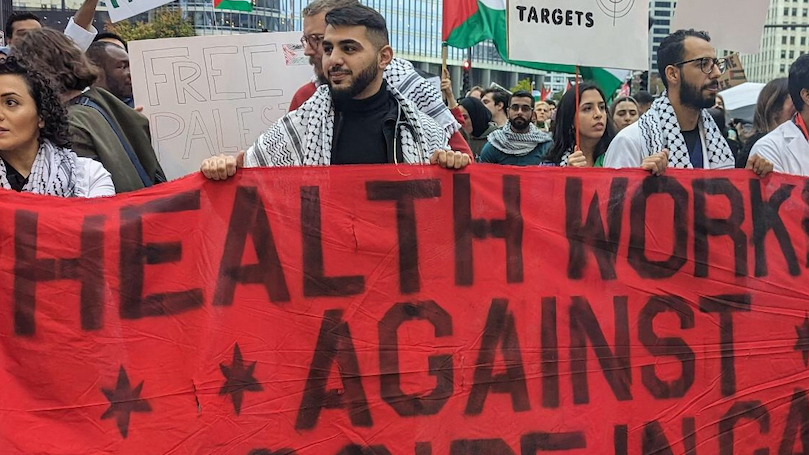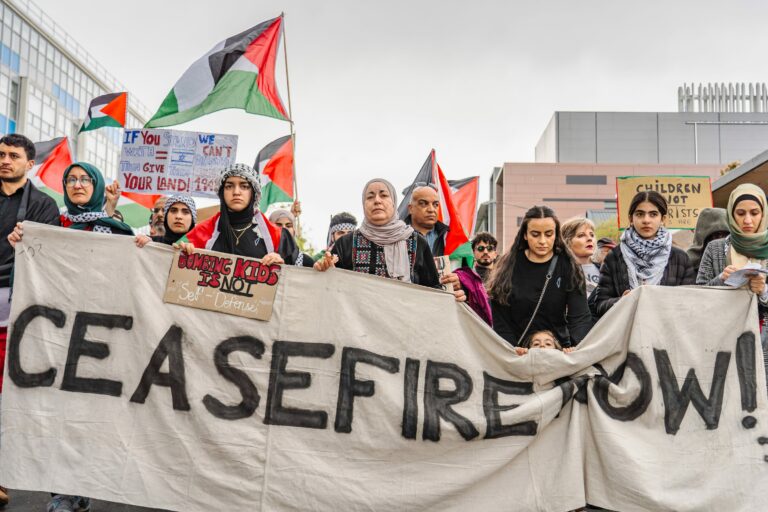
This piece is a contribution to the Pre-Convention Discussion for our 32nd National Convention. During Pre-Convention Discussion, all aspects of the party’s program, strategy, and tactics are up for consideration and debate. The ideas presented here are those of the author or authors alone, and do not necessarily reflect the positions of the Communist Party USA, its membership, or their elected leadership bodies. — Editors
A remarkable development of the past six months has been the mobilization of organized labor in the movement for a ceasefire in Gaza. Days into Israel’s retaliatory war on Gaza, union locals were already pressing for peace. United Electrical Workers, the American Postal Workers Union, and the National Writers’ Union were among the earliest national unions to speak out. A petition circulated in mid-October demands restoration of humanitarian aid and release of the hostages, and calls on President Biden and Congress to push for an immediate ceasefire. This statement has since been affirmed by hundreds of unions, locals and nationals, and thousands of labor activists.
In mid-November, the Coalition of Labor Union Women (CLUW) called not only for a ceasefire, but for a re-ordering of national priorities away from war spending and toward domestic needs. As the death toll in Gaza climbed, more and ever larger unions joined the call. The 400,000 member United Auto Workers called for a ceasefire on December 1, followed by the National Education Association on December 8. The Service Employees International Union, which organizes 1.9 million health care workers and property service workers, called for a ceasefire on January 22. Its statement reads “SEIU members understand that working people often feel the impact of war most deeply and bear the brunt of its terrible consequences.” But the call for peace that represented the largest number of trade unionists was the February 8 AFL-CIO call for a ceasefire by the labor federation that represents 12.5 million workers.
Furthermore, national unions are now more vocal and increasingly willing to take independent leadership in the ceasefire movement. In mid-December, UAW President Shawn Fain joined elected officials and other union leaders in a very public event in front of the White House to endorse House Resolution 786, a ceasefire bill in Congress introduced by Representative Cori Bush. Fain declared that trade unions have responsibilities beyond fighting for workers’ wages and working conditions: “We must fight for all workers and suffering people throughout the world. We must fight for humanity.”
With stronger coalitions under construction, demands have expanded. After weeks of “quiet consolidation,” Labor for a Ceasefire was formed, consisting of seven of the largest unions, and 220 other locals and central labor councils. It emerged in late February with a webinar featuring Fain, Becky Pringle, president of the National Education Association, and two members of Congress: Rashida Tlaib from Michigan and Summer Lee from Pennsylvania.

Labor joins with other sectors of the working class
With these developments, organized labor was joining a movement that included other important sectors of the working class. The African American community contributed the earliest efforts. Representative Cori Bush of St. Louis introduced the “Ceasefire Now” Resolution on October 16, and brought together various constituencies to support her efforts in the House of Representatives, including Black trade unionists like Chelsea Bland of the Coalition of Labor Union Women and Judy Beard of the American Postal Workers Union. On November 8, 2023 a coalition of more than one thousand Black pastors issued a moral call for a ceasefire, and also warned the Biden administration of political consequences unless it does everything it can to stop Israel’s offensive in Gaza.
One organization mobilized by Rep. Bush was the Coalition of Black Trade Unionists (CBTU). The president of the St. Louis Chapter, Jay O’zier, spoke at the reelection kick-off for Bush. “In the black community,” O’zier said in an interview, “people are politically aware and are calling it a genocide.” African Americans were joined in the movement for a ceasefire by other people of color, including Asian-Americans and Arab Americans.
Move the money from the military budget to meet the needs of working families
Months before the Hamas attacks on Israel, a Peace Conference had been in the works that would bring different elements of the working class together in the interest of peace. It would call for a reduction of the military budget, and redirection of those resources to domestic needs of working people. The conference took place in November, just weeks into the war in Gaza. At a kick-off Town Hall sponsored by the People’s World, John Braxton, long-time labor activist and organizer for Veterans and Labor for Sensible Priorities, called for a ceasefire, and went further to support Representative Barbara Lee’s bill that would cut $100 billion from the Pentagon budget and divert those funds to human needs: health care workers, teachers, green energy jobs, etc. Braxton said some portion of the money saved must go toward a “just transition,” making sure that workers in the industries of war could shift to jobs that serve people’s real needs.
In a recent discussion of the AFL-CIO’s resolution, most labor and peace activists in the room viewed the development as one worth celebrating. Joe Henry , labor activist and former field operations assistant director for Teamster General President Ron Carey, contrasted it with the AFL-CIO of thirty years ago, when the leadership would have shut down anti-war efforts before they got to a vote. Now, national union leadership is younger, more open, and more receptive to grassroots demands. This development was recognized as the “fresh winds” in the labor movement brought about by rank-and-file workers and local union leaders. It was the grassroots, Henry pointed out, that enabled the labor militancy of the last year, when 1.5 million workers went out on strike and very strong contracts were won. “Whenever you go from ‘no’ to ‘yes’ is a victory,” said Kooper Caraway, former president of the South Dakota Federation of Labor. Beatrice Lumpkin, a founding member of the Coalition of Labor Union Women and Chicago Teachers Association activist, said she was pleased with the resolution: “It’s moving us forward and will open a lot of doors. We have to build on it.” Labor activist Roberta Wood said we should applaud the resolution, “And ask, what should we push for next? It might be a statement on ending U.S. military aid to Israel or reducing the U.S. military budget.”

A brand new moment in the history of the AFL-CIO?
Is taking a stand against an imperialist foreign policy a brand new moment in the long history of the AFL-CIO? In the years after the George W. Bush administration invaded Iraq in 2003, many unions passed anti-war resolutions. Representatives from about 200 organizations formed US Labor against War (USLAW), which pressured the AFL-CIO to oppose the war. The Federation finally issued a call in 2005 to bring troops and resources home. In 2011 it took a similar stance against the war in Afghanistan and reiterated those positions in 2017. “What is different this time,” John Braxton said about the current resolution for a ceasefire in Gaza, “is that it’s the first time that national unions and the AFL came out so promptly against the war. In the case of Iraq and Afghanistan, it took years.”
In the long history of the federation, the turn-around is even more dramatic. The American Federation of Labor and the Congress of Industrial Organizations merged in 1955 at the height of the Cold War. Communists and other militant trade unionists had been purged from union membership in the Taft Hartley bill of 1947. George Meany, president of the more conservative AFL since 1952, became the first president of the newly merged federation, and fully embraced the requirement that trade unionists sign the anti-communist affidavit. The removal of the labor movement’s most radical, passionate, and committed members meant that “those left behind in union leadership survived by personal timidity and patriotic zeal,” according to labor historian Mark Dunbar.
George Meany claimed that foreign policy issues were not labor’s concern. However, he acted otherwise, supporting the U.S.’s crackdown on left-wing governments in Central and South America and in Asia. The 1972 presidential election pitted Republican incumbent Richard Nixon against Democrat George McGovern, who opposed the Vietnam War. Meany refused to endorse McGovern, calling him an “apologist for the Communist world.” Under Meany’s leadership, the AFL-CIO effectively shut down union leaders who had joined in the anti-war movement as early as 1965.
Labor’s historic participation in anti-war coalitions underestimated
As a result, labor’s participation in anti-war coalitions is routinely underestimated. In U.S. Labor in the Viet Nam War, Philip Foner wrote that popular accounts of the anti-war movement of the 1960s and ’70s either ignore workers or portray them as “monolithic supporters of the U.S. government and its foreign policy.” Top leadership may have been in the pocket of U.S. imperialists, but that sentiment was not echoed throughout the rank-and-file membership or its local leaders. “Unions had a complicated and multi-faceted relationship to the anti-war movement, and in many respects, unions supported its initial existence,” historian Jason Long wrote. Although organized labor was crucial to broadening the anti-war coalition, its impact was marginalized by “media alienation, internal divisions, and institutional meddling.”

Lane Kirkland, who replaced Meany in 1979, was similarly anti-Communist. Kirkland readily aligned official labor’s foreign policy with Republican presidents Ronald Reagan and George Bush. Far from believing that trade unions had no role to play in foreign policy, the Federation spent more on international affairs in those years, subsidized by the Department of State, than it did on its domestic issues. Leftists of the time sometimes referred to the federation as “AFL-CIA.” The idea that the AFL-CIO would ever support the Palestinians’ cause would have seemed preposterous at the time.
Things began to change with the election of John Sweeney in 1995. Sweeney’s style was said to be more like the old CIO organizers. Under his leadership, the anti-Communist affidavit was repealed. Sweeney also promoted substantially more women and people of color into leadership. He appointed Barbara Shailor, a critic of past AFL-CIO complicity with right-wing governments in Central and South America, to the Federation’s International Department, and renamed it the Solidarity Center. He also appointed Richard Trumka, who had led a militant miners’ strike, and Trumka ultimately succeeded Sweeney as president of the Federation in 2009. After Trumka’s death in 2021, Liz Shuler from the International Brotherhood of Electrical Workers was elected the first woman president of the Federation. Her second in command, Fred Redmond, a steelworker, is the highest ranking African American union officer.
The AFL-CIO is a huge and diverse amalgam of the most conservative and the most progressive labor organizations. As Mark Froemke, president of the West Minnesota Area Labor Council, explains it, the fact that “everyone is at the table” is both the best and the worst feature of the federation: it’s a behemoth that isn’t easily steered. But when it acts, it has the power of 12.5 million workers behind it.
Impact of the statements by national unions
What has been the impact of the AFL-CIO statements and others from national unions? Some noticed cracks in the pro-Israel edifice that the Biden administration had built, starting when the president admitted that the Israeli response was “over the top.” On March 2, Vice President Kamala Harris went steps further, calling for an immediate, if temporary, ceasefire. Local labor councils across the country are passing resolutions affirming their national Federation’s stance against the war. Working people are demanding ceasefire resolutions from their local city governments, and to date 77 cities have passed resolutions. Anti-war legislation has been introduced in Congress. For example, Congresswoman Rashida Tlaib told listeners at the Labor for a Ceasefire webinar that “Every bomb that is dropped makes money for members of Congress” who invest in defense contractors. She has proposed the “Stop politicians from profiting from war” Act to ban members of Congress and their families from having financial interests in defense industries. Representatives Barbara Lee and Mark Pocan’s HR 1134 would cut the military budget by $100 billion and redirect the funds for human needs.
How is it that the AFL-CIO has turned itself 180 degrees compared with the Lane Kirkland days? One important factor according to labor activist Joe Henry is that union leadership is finally starting to listen to the demands of the grass roots, rank and file membership, and local union activists. Rashida Tlaib, whose father was a UAW member, credited labor leaders for listening to their membership and letting “much of what they believe to guide your decision. Transformative change comes from the people.” Likewise, Congresswoman Summer Lee said in the same webinar: “Thanks to labor leaders for leading and for listening to your membership.”
Shawn Fain credited workers in the UAW for demanding that their union call for a ceasefire. “I thank our UAW members for speaking out and pushing us to come out in support of a ceasefire… I call on the rest of the labor movement to join us in this mission for peace and social justice for all of humanity.”
The more diverse and open leadership is not due to top-down appointments alone. Movements toward union democracy in national unions like the UAW and the Teamsters also have had an effect in recent years, establishing leadership that is truly accountable to the membership. Whereas in Lane Kirkland’s time, top leaders of the federation would have shut down ideas like the ceasefire in Gaza, current labor leaders are listening. Many middle- and upper-level labor leaders are veterans of the movement against the Vietnam War or were participants in later anti-war organizations of the 2000s like USLAW.
Role of the Communist Party in labor’s anti-war movement
What has the role of the Communist Party been in labor’s anti-war movement? The Taft Hartley Act’s purge of Party members from leadership in trade unions was clearly a setback in the capacity for political action by trade unions. While Party members could not be open about their affiliation in the days of the Vietnam War, they operated under the radar, and some lend continuity between the anti-war movement from the 1960s and 70s right through to today. The anti-communist clause was overturned in the Sweeney years, although vestiges of the restrictions still exist in some corners of organized labor. Since the mid-1990s, opening unions up to participation by Communists meant that some of the most effective organizers were again available to the labor movement. The very word “socialism” was popularized in the campaigns of Senator Bernie Sanders in a way that resonated in the trade union movement. Unions are beginning to recognize their capacity for independent political action.
Some of the very first labor organizations that took a stand are areas where the left has been influential. The Peace Conference that the Party organized in November brought together peace activists with leaders from the youth, environment, women’s, and LGBTQ movements, illustrating coalition-building as one important strength that Communists have brought to the struggle. The power of the ceasefire movement comes from connections among labor organizations, community organizations, and elected officials like Tlaib, who can introduce legislation that reflects people’s demands.
Unlike most of the socialists of his day, Karl Marx recognized the political importance of trade unions, calling them “organizing centers for the working class.” Lenin later echoed Marx, arguing that the leading role of the working class is the most central idea in Marx’s thought, and that unions in turn are the “fundamental mass organizations of the working class.” They saw trade unions as places where workers can stop competing with each other and can instead join forces. Then, they can begin to recognize their power to bring about their complete emancipation, to end the exploitation of workers. In the call for a ceasefire, labor has demonstrated its political autonomy by challenging a sitting president’s policy in the midst of an election. There is no contradiction between that challenge and labor’s endorsement of Biden for reelection later this year. His opponent is a known enemy of the working class. Organized labor recognizes that independent political action by workers is the path to defeat fascism and Trump.
Marx distinguishes between the economic activity and political activity of workers within trade unions but says the two are “inseparably intertwined.” The economic struggle is waged by workers who demand that their employer limit the working day to 8 hours, but the political struggle is to demand an 8-hour working day for all. Marx was critical of unions that focused solely economic demands on a single employer; those unions are “fighting with effects, but not with the causes of those effects,” he wrote in 1866.
The “Communist Plus” that comrades can bring to trade union work is to show that economic gains of better wages and working conditions can lead to political activity to bring about a better world for all. Organized labor’s call for a ceasefire in Gaza isn’t looking at short term gains for organized workers alone, but is, as Shawn Fain put it, a “mission for peace and social justice for all of humanity.” As such, it exemplifies true political struggle by fundamental mass organizations of the working class.
***
Sources
Mark Dunbar, “Populists and Progressives: A brief history of the Democratic Party.” Humanist 80 (1), January/February 2020, 12-17.
Philip Foner, U.S. Labor in the Viet Nam War. (New York: International Publishers, Co., Inc. 1989)
John Kelly, “Marxism and Trade Unionism.” International Union Rights 18, January, 2012
Nelson Lichtenstein, State of the Union: A Century of American Labor. Princeton University Press, 2002
Jason Long, “Organized Labor and the Vietnam Antiwar Movement: Early union mobilization.” https://crimsonhistorical.ua.edu/wp-content/uploads/2023/01/Organized-Labor-and-the-Vietnam-Antiwar.pdf
A. Lozovsky, Marx and the Trade Unions.
Karl Marx, The International Workingmen’s Association, Instructions for the Delegates of the Provisional General Council, 1866.
John Bennett Sears, “Peace Work: The Antiwar Tradition in American Labor from the Cold War to the Iraq War.” Diplomatic History 349 (4) 2010.
Images: Labor Unions Join Congresswomen Bush, Tlaib in Calls for Ceasefire (Creative Commons); Person holding a sign in a crowd (Unsplash License); We remember from Health Care Workers for Palestine (Instagram); Healthcare workers against genocide in Gaza by @lowisiana on X; Labor’s Upsurge from Spectre (CC BY 3.0 NZ);


 Join Now
Join Now